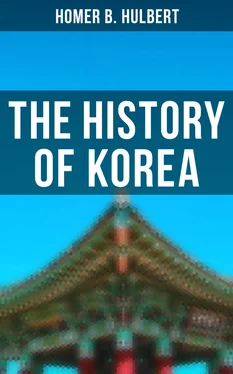We are confronted by the singular statement that at the time of the Wei dynasty in China, 220–294 A.D. Ye-guk swore allegiance to China and despatched an envoy four times a year. There was no Ye-mak in Korea at that time and this must refer to some other Ye tribe in the north. It is said they purchased exemption from military duty by paying a stipulated annual sum. This is manifestly said of some tribe more contiguous to China than the one we are here discussing.
Măk-guk, the other half of Ye-măk, had its seat of government near the site of the present town of Ch’un-ch’ŭn. Later, in the time of the Sil-la supremacy, it was known as U-su-ju. It was called Ch’ŭn-ju in the time of the Ko-ryŭ rule.
The ancient Chinese work, Su-jun, says that in the days of Emperor Mu-song (antedating Ki-ja) the people of Wha-ha Man-măk came and did obeisance to China. This may have been the Korean Măk. Mencius also makes mention of a greater Măk and a lesser Măk. In the time of the Han dynasty they spoke of Cho-sün, Chin-bŭn and Ye-măk. Mencius’ notice of a greater and lesser Măk is looked upon by some as an insult to the memory of Ki-ja, as if he had called Ki-ja’s kingdom a wild country; but the above mention of the three separately is quoted to show that Mencius had no such thought.
The annals of Emperor Mu-je state, in a commentary, that Măk was north of Chin-han and south of Ko-gu-ryŭ and Ok-jŭ and had the sea to the east, a description which exactly suits Ye-măk as we know it.
The wild tribe called Ok-jŭ occupied the territory east of Kă-ma San and lay along the eastern sea-coast. It was narrow and long, stretching a thousand li along the coast in the form of a hook. This well describes the contour of the coast from a point somewhat south of the present Wŭn-san northward along the shore of Ham-gyŭng Province. On its south was Ye-măk and on its north were the wild Eum-nu and Pu-yŭ tribes. It consisted of five thousand houses grouped in separate communities that were quite distinct from each other politically, and a sort of patriarchal government prevailed. The language was much like that of the people of Ko-gu-ryŭ.
When Wi-man took Ki-jun’s kingdom, the Ok-jŭ people became subject to him, but later, when the Chinese made the four provinces, Ok-jŭ was incorporated into Hyŭn-do. As Ok-jŭ was the most remote of all the wild tribes from the Chinese capital, a special governor was appointed over her, called a Tong-bu To-wi, and his seat of government was at Pul-lă fortress. The district was divided into seven parts, all of which were east of Tan-dan Pass, perhaps the Tă-gwul Pass of to-day. In the sixth year of the Emperor Kwang-mu, 31 A.D., it is said that the governorship was discontinued and native magnates were put at the head of affairs in each of the seven districts under the title Hu or Marquis. Three of the seven districts were Wha-ye, Ok-jŭ and Pul-lă. It is said that the people of Ye-guk were called in to build the government houses in these seven centers.
When Ko-gu-ryŭ took over all northern Korea, she placed a single governor over all this territory with the title Tă-in. Tribute was rendered in the form of grass-cloth, fish, salt and other sea products. Handsome women were also requisitioned. The land was fertile. It had a range of mountains at its back and the sea in front. Cereals grew abundantly. The people are described as being very vindictive. Spears were the weapons mostly used in fighting. Horses and cattle were scarce. The style of dress was the same as that of Ko-gu-ryŭ.
When a girl reached the age of ten she was taken to the home of her future husband and brought up there. Having attained a marriageable age she returned home and her fiancé then obtained her by paying the stipulated price.
Dead bodies were buried in a shallow grave and when only the bones remained they were exhumed and thrust into a huge hollowed tree trunk which formed the family “vault.” Many generations were thus buried in a single tree trunk. The opening was at the end of the trunk. A wooden image of the dead was carved and set beside this coffin and with it a bowl of grain.
The northern part of Ok-jŭ was called Puk Ok-jŭ or “North Ok-jŭ.” The customs of these people were the same as those of the south except for some differences caused by the proximity of the Eum-nu tribe to the north, who were the Apaches of Korea. Every year these fierce people made a descent upon the villages of the peaceful Ok-jŭ, sweeping everything before them. So regular were these incursions that the Ok-jŭ people used to migrate to the mountains every summer, where they lived in caves as best they could, returning to their homes in the late autumn. The cold of winter held their enemies in check.
We are told that a Chinese envoy once penetrated these remote regions. He asked “Are there any people living beyond this sea?” (meaning the Japan Sea.) They replied “Sometimes when we go out to fish and a tempest strikes us we are driven ten days toward the east until we reach islands where men live whose language is strange and whose custom it is each summer to drown a young girl in the sea.”Another said “Once some clothes floated here which were like ours except that the sleeves were as long as the height of a man.” Another said “A boat once drifted here containing a man with a double face, one above the other. We could not understand his speech and as he refused to eat he soon expired.”
The tribe of Ok-jŭ was finally absorbed in Ko-gu-ryŭ in the fourth year of King T’ă-jo Wang.
The Eum-nu tribe did not belong to Korea proper but as its territory was adjacent to Korea a word may not be out of place. It was originally called Suk-sin. It was north of Ok-jŭ and stretched from the Tu-man river away north to the vicinity of the Amur. Its most famous mountain was Pul-ham San, It is said to have been a thousand li to the north-east of Pu-yŭ. The country was mountainous and there were no cart roads. The various cereals were grown, as well as hemp.
The native account of the people of Eum-nu is quite droll and can hardly be accepted as credible. It tells us that the people lived in the trees in summer and in holes in the ground in winter. The higher a man’s rank the deeper he was allowed to dig. The deepest holes were “nine rafters deep.” Pigs were much in evidence. The flesh was eaten and the skins were worn. In winter the people smeared themselves an inch thick with grease. In summer they wore only a breach-cloth. They were extremely filthy. In the center of each of these winter excavations was a common cesspool about which everything else was clustered. The extraordinary statement is made that these people picked up pieces of meat with their toes and ate them. They sat on frozen meat to thaw it out. There was no king, but a sort of hereditary chieftainship prevailed. If a man desired to marry he placed a feather in the hair of the damsel of his choice and if she accepted him she simply followed him home. Women did not marry twice, but before marriage the extreme of latitude was allowed. Young men were more respected than old men. They buried their dead, placing a number of slaughtered pigs beside the dead that he might have something to eat in the land beyond the grave. The people were fierce and cruel, and even though a parent died they did not weep. Death was the penalty for small as well as great offences. They had no form of writing and treaties were made only by word of mouth. In the days of Emperor Yüan-ti of the Eastern Tsin dynasty, an envoy from this tribe was seen in the Capital of China.
We have described the tribes of eastern Korea. A word now about the western part of the peninsula. All that portion of Korea lying between the Han and Yalu rivers constituted what was known as Nang-nang and included the present provinces of P‘yŭng-an and Whang-hă together with a portion of Kyŭng-geui. It was originally the name of a single tribe whose position will probably never be exactly known; but it was of such importance that when China divided northern Korea into four provinces she gave this name of Nang-nang to all that portion lying, as we have said, between the Han and the Yalu. The only accounts of these people are given under the head of the Kingdom of Ko-gu-ryŭ which we shall consider later. But between Nang-nang and the extreme eastern tribes of Ok-jŭ there was a large tract of country including the eastern part of the present province of P’yŭng-anand the western part of Ham-gyŭng. This was called Hyŭn-do, and the Chinese gave this name to the whole north-eastern part of Korea. No separate accounts of Hyŭn-do seem to be now available.
Читать дальше









